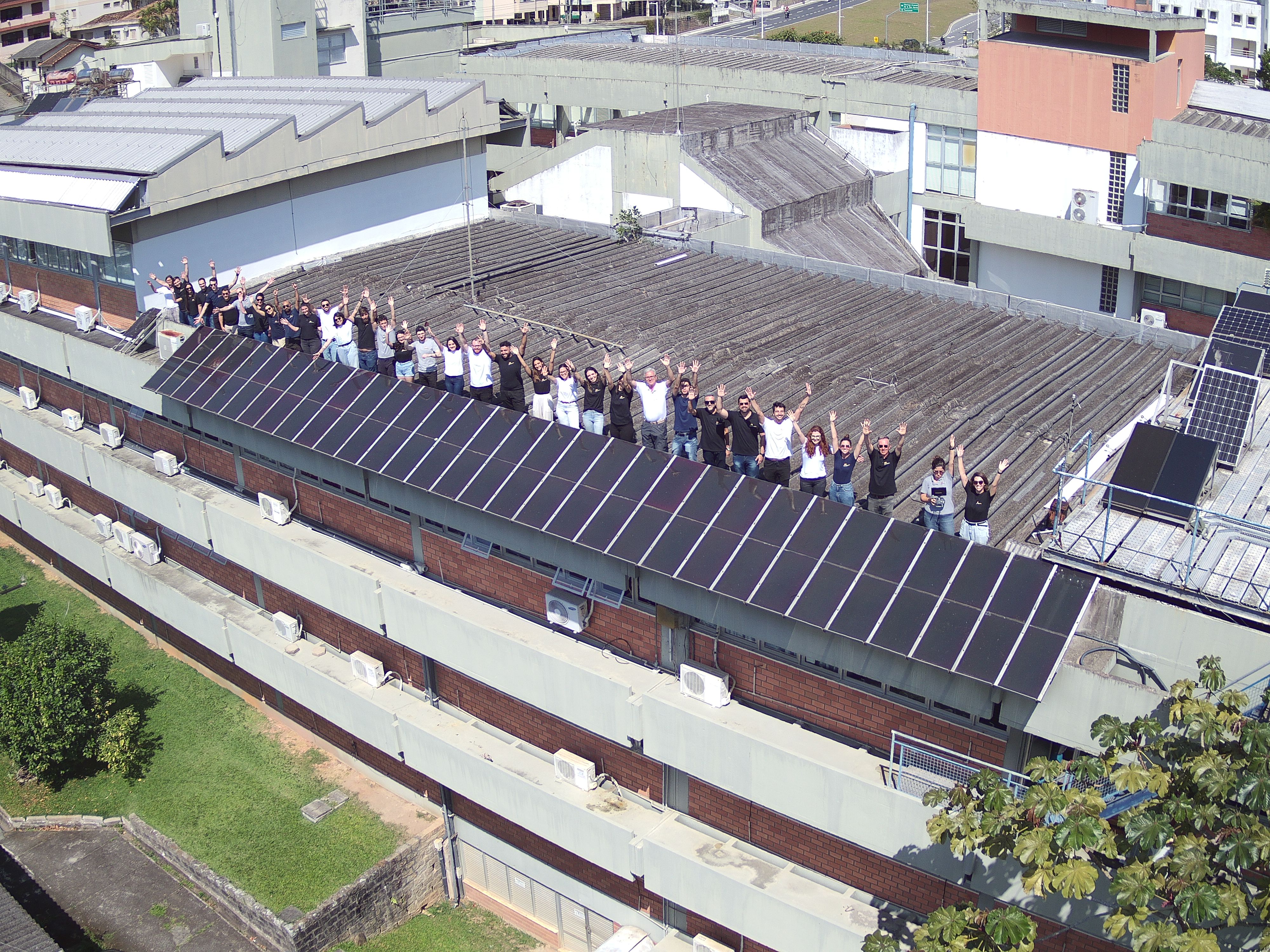Solar Energy in Brazil: The Next Powerhouse
Authors: Dr. Aline Kirsten Vidal de Oliveira, Dr. Marcelo Almeida, Marília Braga
Brazil isn't just embracing solar energy—it’s revolutionizing its potential in the global energy sector. As we count down to the Solar World Congress 2025 in Fortaleza, let’s dive into Brazil’s solar energy history.
Fifteen years ago, no one could have imagined that Brazil would become one of the world’s largest powers in photovoltaic solar energy. And for good reason—until 2010, the country had only a few dozen megawatts installed in the form of isolated systems distributed throughout the country, mainly in the North and Northeast regions. These systems were largely encouraged and financed by government rural electrification programs, such as the "Luz para Todos" (Light for All) Program.
At that time, 36-cell crystalline silicon photovoltaic modules, lead-acid batteries, and low-power grid-forming inverters dominated the market. These systems, which were eventually called SIGFI—Individual Generation System from Intermittent Sources—after the publication of the National Agency of Electrical Energy’s (ANEEL) Normative Resolution 83, were extremely important in aiding the process of universalizing access to electricity and in laying the foundation for today’s national photovoltaic solar giga-market. Alongside these were isolated microgrids, mostly powered by solar energy, which complemented rural electrification efforts in areas with enough nearby consumers to make the installation of a small electrical grid technically and economically viable.
During the era of isolated systems, some companies began to recognize Brazil’s potential for photovoltaic generation. But it wasn’t only the private sector that became interested in this source—the public sector also began seriously considering the possibility of expanding the electricity matrix with photovoltaic solar energy. The Brazilian government already had some experience with intermittent renewable sources, then called alternative sources, such as solar thermal for heating and wind power for electricity generation. However, it was through the encouragement and national support of pioneering companies that commercialized and installed photovoltaic components and systems, the first consumers of this technology, and, most importantly, researchers and professors who staked their careers on a vision of the future where photovoltaic generation would play a leading role, that different government agencies began working to enable photovoltaic solar energy to grow and become a key player in the national electricity system.
The first grid-connected photovoltaic systems were installed in the country as early as the 1990s. The technology was already widely used worldwide but was just arriving in Brazil. These pioneering systems were small in power but enormous in significance, as they allowed utilities to experience the process of connecting photovoltaic generation systems to the grid for the first time, as well as providing an unprecedented demonstration of the technology’s operation for decision-makers. Many of these systems were installed in universities and research centers, where various studies were conducted to assess the technical, economic, and regulatory feasibility of the technology, forming the basis for public policies in the following years. In this academic context, the importance of the Brazilian Solar Energy Association (ABENS) stands out—an association that, since 1978, has brought together researchers, professors, students, professionals, and solar energy enthusiasts to promote studies, dissemination, and use of solar energy technologies. Among ABENS' activities, its biennial congress, held since 2007 to bring together the sector’s leading experts, is particularly noteworthy.

The first grid-connected, building-integrated photovoltaic (BIPV) installation in Brazil in Florianópolis (27°S, 48° W). The photovoltaic (PV) installation has an installed power of 2.078 kWp and started operating in 1997.
Moving into the 2010s, Brazil saw a movement that would gain increasing momentum. Observing the success of grid-connected photovoltaic generation abroad, particularly in Europe and the United States, various Brazilian entrepreneurs came together to organize what would become today’s solar photovoltaic market. Some initiatives deserve mention, such as the creation of the Photovoltaic Sector Group of the Brazilian Association of Electric and Electronic Industry (ABINEE), the Brazilian Photovoltaic Solar Energy Association (ABSOLAR), and the Brazilian Distributed Generation Association (ABGD). From the government’s side, and as a result of the efforts of various researchers and professors who for years provided input for public agents and encouraged photovoltaic technology, ANEEL published Normative Resolution 482 in 2011, which regulated distributed generation in the country. Additionally, R&D initiatives from ANEEL in 2011 created a small initial market for grid-connected photovoltaic generation.
From that point forward, Brazil and the world witnessed exponential growth in photovoltaic generation in the country. Starting with less than 50 MW at the beginning of the 2010s, mostly from isolated systems, solar photovoltaic power reached over 50 GW of installed capacity by early 2025—an increase of more than 1,000 times—now representing about 1.7% of the national electric energy matrix. In 2024, Brazil ranked among the top five largest solar photovoltaic markets globally. In terms of installed capacity, the country was among the top 10 worldwide. This growth can be attributed to several factors: Brazil benefits from high solar irradiation levels, predominantly in the Northeast and Central-West regions, making it an ideal location for solar power generation; the government has established encouraging policies, such as fiscal incentives, tax reductions, and distributed generation regulations, including a net metering arrangement that allows consumers to generate their own power and receive credits for surplus energy injected into the grid; the falling costs of photovoltaic equipment have made solar power more accessible to companies and consumers; enhanced financing mechanisms for solar programs have been introduced; and there is also a growing concern for environmental sustainability.
Currently, around 67% of installed photovoltaic capacity is in distributed generation. This trend is primarily driven by the high economic attractiveness of the investment, resulting from a combination of high electricity tariffs in the captive market, attractive financing options, and high solar radiation incidence across most of the national territory. Centralized generation—i.e., large power plants directly connected to the transmission or sub-transmission system—experienced considerable growth at the start of the solar photovoltaic boom in the 2010s. However, its expansion has slowed due to several factors, such as rising interest rates making large-scale financial investments less attractive, increased competition with other sources, regulatory uncertainties—particularly regarding transmission grid connection and power flow feasibility—among others. Nevertheless, these factors have not halted the growth of centralized generation, which continues to expand, albeit at a slower pace than distributed generation.
This expanding market has brought numerous benefits to the country.
Over the past 15 years,
- more than 1.6 million jobs have been created,
- US$ 43 billion has been invested in solar photovoltaics,
- 65.6 million tons of carbon emissions have been avoided,
- and dependency on hydro and thermal sources has decreased.
The latter is particularly important in recent years, as the share of hydroelectric generation has declined due to environmental phenomena affecting rainfall patterns.
Photovoltaic generation has enabled Brazil to rely less on thermal sources, which are more expensive and polluting.
To illustrate the role of photovoltaic generation in meeting national electricity demand, two significant records were set in 2024.
- On October 7, 14.36% of the daily average demand, about 11.9 GW, was met by photovoltaic generation,
- and on the same day, at 11:00 AM, photovoltaic energy supplied 40.03% of the country’s total demand, corresponding to just over 36 GW.
These records highlight the growing importance of solar energy in Brazil’s energy landscape and its potential to soon become a major force in the country’s energy transition.
Solar Energy: A Key to Decarbonizing Isolated Systems in the Amazon
Despite Brazil’s Integrated National Power System covering most of the country, isolated regions, such as the Amazon, rely on isolated power systems heavily dependent on fossil fuels, predominantly diesel generators. These systems are not only costly but also contribute significantly to greenhouse gas emissions. In 2022, over US$ 2.3 billion was spent subsidizing diesel fuel for these isolated systems, according to an ANEEL report. In this context, solar energy presents a low-cost, eco-friendly alternative. The abundant solar irradiation in the Amazon region makes it an ideal location for photovoltaic systems, whether in the form of solar home systems or microgrids, which can significantly reduce reliance on diesel, lower greenhouse gas emissions, and provide a more reliable energy source for remote communities.
As time has passed, several barriers have had to be overcome by the photovoltaic solar sector, enabling its evolution to its current level.
Among the present challenges, we can highlight the following challenges:
- economic, regulatory, and technical factors, such as the increase in the exchange rate of the Real against the Dollar;
- the rise in interest rates in the country;
- the reduction of subsidies;
- high competition, especially in distributed generation, which reduces profit margins;
- quality issues with equipment, with the so-called "fake power" being one of the most discussed topics at the moment;
- growing restrictions on energy injection into the grid due to a lack of investment in distribution and transmission networks;
- the still high cost of energy storage systems, a fundamental technology for increasing the share of photovoltaic generation in the electrical system;
- the reluctance of some distributors to accept the connection of distributed generation systems;
- the unequal distribution of distributed generation systems among different socioeconomic classes of the population;
- and the increasing environmental concerns caused by the installation of ever-larger photovoltaic plants, among others.
The Role of SWC 2025 in Advancing Solar Energy
Given this landscape of opportunities and challenges, the Solar World Congress 2025 in Brazil is particularly timely. The congress serves as a key international platform for discussing solar energy advancements and challenges. It brings together experts, policymakers, and industry leaders from around the world to exchange insights on the latest technologies, policies, and strategies to accelerate the adoption of solar energy. SWC 2025 will take place in Fortaleza, the capital of the state of Ceará. The choice of this location is ideal, as Ceará has emerged as a leader in Brazil’s renewable energy sector, not only in solar energy but also in wind power and green hydrogen. With high solar energy potential and a strategic location, Ceará is attracting massive investments in green hydrogen projects that play a key role in decarbonizing transportation and industries.
Abstract submission for the Solar World Congress 2025 is now open:www.solarworldcongress.org
References:
-
Luz para Todos Program (n.d.). Ministério de Minas e Energia. Retrieved from https://www.mme.gov.br
-
ANEEL Normative Resolution 83 (n.d.). Agência Nacional de Energia Elétrica. Retrieved from https://www.aneel.gov.br
-
Brazilian Solar Energy Association (ABENS). (2023). History and Contributions to Solar Energy in Brazil. Retrieved from https://www.abens.org.br
-
National Agency of Electrical Energy (ANEEL). (2011). Normative Resolution No. 482: Distributed Generation Regulation. Retrieved from https://www.aneel.gov.br
-
Brazilian Association of Electric and Electronic Industry (ABINEE). (2015). Photovoltaic Sector Group: Strengthening Brazil's Solar Energy Market. Retrieved from https://www.abinee.org.br
-
Brazilian Photovoltaic Solar Energy Association (ABSOLAR). (2020). Brazil's Solar Energy Market and Policy Developments. Retrieved from https://www.absolar.org.br
-
Brazilian Distributed Generation Association (ABGD). (2019). Distributed Generation and the Growth of Solar Energy in Brazil. Retrieved from https://www.abgd.org.br
-
U.S. Department of Energy. (2024). The Global Solar Photovoltaic Market: Trends and Opportunities. Retrieved from https://www.energy.gov
-
Brazilian Institute of Geography and Statistics (IBGE). (2023). Brazil's Regional Solar Irradiation and Economic Impact. Retrieved from https://www.ibge.gov.br
-
International Renewable Energy Agency (IRENA). (2024). Renewable Energy and Solar Power's Role in Brazil's Energy Transition. Retrieved from https://www.irena.org
-
International Energy Agency (IEA). (2024). Global Energy Market Review: Solar Power and Brazil’s Role in Global Trends. Retrieved from https://www.iea.org
-
ANEEL (2022). Energy Subsidies and Impact on Brazil's Isolated Systems: A Shift to Solar Power. Retrieved from https://www.aneel.gov.br
-
Waisman, H., & Costa, P. M. (2021). Renewable Energy Sources in Brazil: A Pathway to Sustainability. Energy Policy Journal, 49(3), 162-174.
-
Solar Energy in the Amazon. (2023). Advances in Solar Energy for Isolated Systems in Brazil’s Amazon Region. Renewable Energy Review, 12(7), 99-110.
-
Brazilian Solar Industry Report. (2024). The Economic and Environmental Impact of Solar Power in Brazil. Retrieved from https://www.solarreport.org.br
